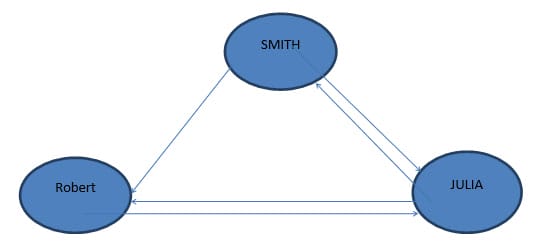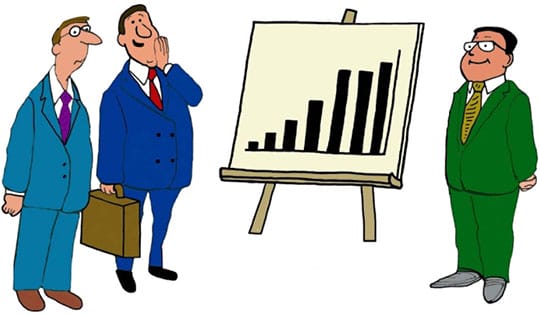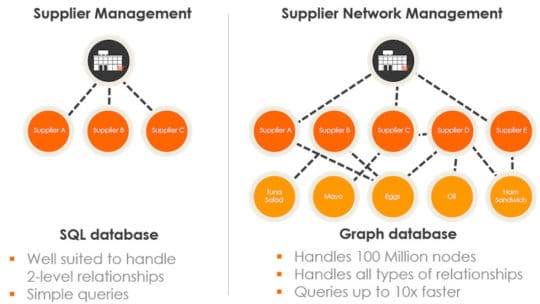The graph database (wiki) is now a buzzword, as the technology is growing fast and businesses can’t afford to ignore this as due to the immense benefits, this technology offers it is rightly being predicted as the future of DBMS (Database Management Systems). Some important graph database examples are Neo 4J, Amazon Neptune, and Orient DB. For all inquisitive readers who are keen to know what a graph database is and what are its major benefits, this article is an effort to provide requisite information:
What Is A Graph Database?

Simply defined, it is a collection of nodes (entities) and edges (relationships). The graph database, unlike other databases, store relationships inherently or by default. This implies that in the graph database, relationships are treated as equally important (or rather more important) than data itself. Nodes are assigned with any number of key-value pairs or attributes which are called properties. Edges or relationships carry directed and named relationships (which are semantically relevant connections). The example of the relationship between two nodes is an employee working for a company. For having a better understanding of what a graph database is, see the graphical illustration below:
Entities and Their Relationships-Twitter Example

Each line shows, which two Persons follow each other.
The above illustration consists of a very small portion of Twitter that has millions of inter-connected account holders. We have chosen only three users, Julia, Robert, and Smith. These are nodes (entities-persons in this illustration). In a very simplified manner, the other part of the graph database i.e. relationships is shown through arrows showing how these users are connected with each other. The illustration shows that all follow each other, there is only one exception; Robert does not follow Smith.
This is a world of inter-connectivity; we are living in today. Twitter, Facebook, Instagram, and other social media platforms explain well how much connected the nodes/entities (persons for example) are with multiple nodes through edges or relationships.
Recommended for you: Can Big Data Help Save Endangered Species? If Yes, How?
Why Does an Enterprise Need Graph Database?

Why graph database is so quickly evolving as a mainstream database management system? What is so charming about it that giants like Google, Facebook, Twitter, and IBM are its adaptors? Today’s business enterprises, amidst stiff competition, require speedy and meaningful information in order to take timely decisions. They want to use a database for problem-solving, customer analytics, real-time updates, and faster queries and serves all this and many more purposes effectively. Let’s check out some significant advantages for enterprises:
a. Meaningful MIS:
 The MIS requirements of today’s business necessitate that CIO’s and CEO’s get the reports with insight rather than mere heaps of statistical figures. The graph database matters a lot in fulfilling this need because instead of focusing on individual data points (as is the case with relational database systems), its prime focus is on relationships of those data points.
The MIS requirements of today’s business necessitate that CIO’s and CEO’s get the reports with insight rather than mere heaps of statistical figures. The graph database matters a lot in fulfilling this need because instead of focusing on individual data points (as is the case with relational database systems), its prime focus is on relationships of those data points.
It is built on interlinked information that is factual. Thus, it represents knowledge. It is therefore very easy for humans and machines to interpret the information stored in a graph database, unlike a traditional relational database. It is due to this factor that graph databases are so effective in providing knowledgeable responses for queries.
b. High Performance:
 More and more companies are adopting it because of its substantially high-performance level compared to relational database systems. For each Join statement, the relational database has to look for another index in yet another data set. The SQL queries quite often require so many joins statements that make the data query process extremely slow. The graph database using its pointer arithmetic, which is present in the cache, performs the query operation in a far less compute-intensive manner resulting in a very fast query handling.
More and more companies are adopting it because of its substantially high-performance level compared to relational database systems. For each Join statement, the relational database has to look for another index in yet another data set. The SQL queries quite often require so many joins statements that make the data query process extremely slow. The graph database using its pointer arithmetic, which is present in the cache, performs the query operation in a far less compute-intensive manner resulting in a very fast query handling.
c. Benefits for Retail Business:
 Besides supply chain Management benefits, which we will discuss in a bit detail separately, there are many benefits which it offers for retailers. Let’s check out some of these:
Besides supply chain Management benefits, which we will discuss in a bit detail separately, there are many benefits which it offers for retailers. Let’s check out some of these:
- Same day delivery services: The surge in consumer data because of the rising of online shopping and social media, have outpaced the capacity of relational databases. Now retail businesses are in a dire need to have the fastest possible delivery system. Graph database efficiently serves this purpose. To bolster its same-day delivery system; eBay is already using the tool.
- Monitoring online shopping behavior: Walmart is using a graph database to collect and analyze peer-to-peer information about consumer’s preferences about products and desired price points.
- Know your customer through Analytics: With strong analytics of graph database, businesses are gaining great insight into consumer behavior and preferences. This helps those in devising effective marketing strategies. Since graph databases also provide useful information about product pricing, they can launch effective promo coupons or discounts and deals. Graphs also provide a wealth of information about browsing and purchasing history of consumers, thus enabling to the target audience for coupon marketing. For instance, based on information obtained from the graph database, eCommerce brands can send personalized coupons to cart abandoners. For example, Vimeo which is a web video store to help people create, discover, share and sell videos, uses analytics intelligently to launch their Vimeo coupons in boosting its sales revenue. It consistently offers discount coupons for new subscribers to improve it’s brand’s image and customer base.
d. Supply Chain Management:
 It is very efficient in modeling and storing data. It is also capable of querying relationships, which relational database systems can’t handle satisfactorily. Graph Database, due to this edge, can effectively provide a transparent supply chain ensuring a year-round supply of products and tracing suppliers and facilities. A graph database is a viable option in effective supply chain management because it is capable of handling large interconnected data.
It is very efficient in modeling and storing data. It is also capable of querying relationships, which relational database systems can’t handle satisfactorily. Graph Database, due to this edge, can effectively provide a transparent supply chain ensuring a year-round supply of products and tracing suppliers and facilities. A graph database is a viable option in effective supply chain management because it is capable of handling large interconnected data.
The impressive performance of graph database in the area of supply chain management is the result of the following factors:
- Graph database has enormous scalability and can grow and adapt to any size. No matter how large a supply chain network is, the graph database can handle it because of its capability to add as many nodes as required.
- Graphs can manage any network no matter how complex that is. There are global networks of suppliers for certain products, spread in many countries, which in turn have their own suppliers. Even in these complex networks, graph database will perform excellently because of their inherent property of storing nodes with scores of interconnections with edges.
- The graph databases have the capability to search swiftly and strongly across vast data sets and this robust searching ability makes it competent to search products, suppliers, manufacturers and facilities across complex supply chain networks.
Supply Chain Management Solutions-Relational VS Graph database
You may like: How a Data Management Platform (DMP) Work for Digital Marketing?
Major Advantages of Graph Database:
Graph database advantages are too many. Here I will discuss some of the most significant benefits:

a. Speed:
 The graph database handles big data at a very fast speed and this is one of the top significant factors of its popularity in the corporate world. Tech Validate and IBM conducted a survey in 2017 about knowing reasons for worldwide adoption of graph databases. According to the finding of this survey, 57% of users across all industries mentioned speed as top technology benefit of a graph database.
The graph database handles big data at a very fast speed and this is one of the top significant factors of its popularity in the corporate world. Tech Validate and IBM conducted a survey in 2017 about knowing reasons for worldwide adoption of graph databases. According to the finding of this survey, 57% of users across all industries mentioned speed as top technology benefit of a graph database.
b. Transformation:
 The graph database is capable to metamorphose the enterprise data management in a big way. It is the driving force behind a complete transformation of data management of an organization to convert it into an all-around and interconnected system that provides a holistic view to Management and stakeholders.
The graph database is capable to metamorphose the enterprise data management in a big way. It is the driving force behind a complete transformation of data management of an organization to convert it into an all-around and interconnected system that provides a holistic view to Management and stakeholders.
The BBC has used the graph database “Ontotext” to integrate its most precious data resources. This integration has immensely benefited the financial industry where, graph database along with other semantic technologies, has provided innovative solutions in the areas of fraud detection and compliance management by bringing in transformation in existing systems.
c. Easy Data Analysis:
 One of the major benefits of a graph database is that they allow data analysts to easily navigate the data sets, unlike relational databases where they have to create and run highly complex queries in order to join tables. According to Kirk Borne who is a principal data scientist at consulting firm Booz Allen Hamilton, “Graphs make more sense from data recovery perspective”. He explains it further and reveals that very clear patterns are obtained when data analytical tools and graph algorithms are applied on data sets available in a graph database, thus making it easy for the analysts to cluster, search, estimate, partition and perform many other basic functions.
One of the major benefits of a graph database is that they allow data analysts to easily navigate the data sets, unlike relational databases where they have to create and run highly complex queries in order to join tables. According to Kirk Borne who is a principal data scientist at consulting firm Booz Allen Hamilton, “Graphs make more sense from data recovery perspective”. He explains it further and reveals that very clear patterns are obtained when data analytical tools and graph algorithms are applied on data sets available in a graph database, thus making it easy for the analysts to cluster, search, estimate, partition and perform many other basic functions.
d. Enhanced Flexibility:
 Relational databases are often criticized by technology experts for their fixed schema, which is increasingly becoming irrelevant for today’s business requirements where due to constant evolution; there is a new requirement each day. Graph databases can best cope with this ever-changing scenario because it considers edges as “first class citizens” alongside vertices (entities). This way, the graph database enables its underlying database engine to navigate and search through networks of nodes and edges in any direction.
Relational databases are often criticized by technology experts for their fixed schema, which is increasingly becoming irrelevant for today’s business requirements where due to constant evolution; there is a new requirement each day. Graph databases can best cope with this ever-changing scenario because it considers edges as “first class citizens” alongside vertices (entities). This way, the graph database enables its underlying database engine to navigate and search through networks of nodes and edges in any direction.
The flexibility of the graph database is one of the significant factors, responsible for its surging popularity in recent years.
Comparison Between Relational, Key-Value and Graph Database:
I will compare relational and key-value databases with graph database to highlight major differences and relative advantages.
Structure:
 In a relational database, data is stored in a tabular form. Each table records data in a fixed format with a specific number of columns. A key value database basically consists of two column hash table. Each row in this table carries a unique ID and a corresponding value associated with that. While searching the key fields single data values are returned. In a graph database, relationships are stored as data with nodes and attributes. In the above diagram, suppliers, customers, and products, etc. are nodes interconnected with each other. The schema is the structure described in a formal language. The rigid format of the relational database demands a rigid schema and since the graph database is highly flexible in nature its schema is also very flexible.
In a relational database, data is stored in a tabular form. Each table records data in a fixed format with a specific number of columns. A key value database basically consists of two column hash table. Each row in this table carries a unique ID and a corresponding value associated with that. While searching the key fields single data values are returned. In a graph database, relationships are stored as data with nodes and attributes. In the above diagram, suppliers, customers, and products, etc. are nodes interconnected with each other. The schema is the structure described in a formal language. The rigid format of the relational database demands a rigid schema and since the graph database is highly flexible in nature its schema is also very flexible.
Transactions:
 Relational database suits well for transactions only without any consideration for its link to other transactions. Key-value database also returns a single value on searching and therefore for real-world transactions, that involve writing multiple records, the key-value database might be incorrect. A graph database is capable of navigating through complex networks of interconnected relationships is the best among all three and tackles the complex transactions well.
Relational database suits well for transactions only without any consideration for its link to other transactions. Key-value database also returns a single value on searching and therefore for real-world transactions, that involve writing multiple records, the key-value database might be incorrect. A graph database is capable of navigating through complex networks of interconnected relationships is the best among all three and tackles the complex transactions well.
Analytics:
 The table structure of the relational database limits the analytical capability because it cannot capture all the information attached to connections. Graph databases are very good tools for analytics because they capture information about entities and their attributes, a property which neither key-value nor relational database possesses.
The table structure of the relational database limits the analytical capability because it cannot capture all the information attached to connections. Graph databases are very good tools for analytics because they capture information about entities and their attributes, a property which neither key-value nor relational database possesses.
You may also like: How Data Protection Changes Affect Small Businesses?
Wrap Up:

The growth of the graph database in leaps and bounds and its adoption by big brands is clearly indicating its future. It is sure to evolve into a great platform for businesses, especially eCommerce for having an in-depth all-round and holistic view about their performance. From compliance management to fraud detection and supply chain to digital marketing, its benefits are so great that it will be really difficult for enterprises to ignore it.
This article is written by Jake James from EmuCoupon.com. He is a blogger, traveler, and a deep thinker. Jake loves to write on all topics especially technical, fashion, traveling and so on. Writing is his passion and therefore, he read a lot too to get ideas and to explore different topics.







